| 4th Annual Tri-State Pottery Festival, PLate Turners Handbook, June 20, 21, 22, 1991. |
East Liverpool Ice and Coal Company
A GIANT REMEMBERED:
A LOOK AT THE WEBBER BREWERY
By GEORGE BARTHOLOMEW
While potteries are generally thought of as the East Liverpool industry, there have been other non-pottery business concerns that have made their mark on the City. In 1900, a group of men headed by S. J. Wainwright organized "The Crockery City Brewing Company". The new brewery building opened its doors for business on September 27, 1900 and was, at that time, the tallest building in Columbiana County. This "new" building remains standing on Webber Way, although additional auxiliary buildings were added through the years.
Not surprisingly, the years of Prohibition played havoc with the brewing industry and required diversification into other areas. Crockery City Brewing became known as the Crockery City Ice and Products Co. However, at the end of Prohibition in 1933, the company, now headed by Ambrose E. Webber and his son, Leonard, was one of the first breweries in the State of Ohio to open for business under the new federal laws. In 1946, the Webber interests were sold and the brewery became "The Webb Corporation", with its stock distributed to various shareholders in East Liverpool, Lisbon, Wellsville, Akron, Canton and elsewhere. A little known fact is that the Webber Brewery, from the end of prohibition through the year 1950 paid Federal and state taxes in the amount of $8,381,152.87. The corporation was also one of the largest industrial contributors to local taxes.
From its inception, and continuing on through the early 1950's, the Webber Brewery averaged from 60 to 75 employees with an average annual payroll of approximately $200,000. After its opening, the Webb Corporation was involved in every "wet" and "dry" election that was held in the city and county. It also actively participated in the fight against the possible return of Prohibition.
During the years, many changes took place at the plant. For example, the bottling house was rebuilt and then later enlarged and modernized. In 1948, new aging cellars were built. By 1950, automatic refrigeration had been installed. At the time of the "Golden Jubilee" celebration in 1950, new steam boilers were in operation, eliminating all smoke, which contributed greatly to the smoke abatement program, then in progress in East Liverpool. Also at this time, new equipment was added for the handling of the company's barley malt, which was shipped in from the great grain fields of the midwest and, of course, hops from the more favorable climates of Oregon and Czechoslovakia. By 1950, the Webb Corporation was considered an ultramodern brewery and an industrial enterprise which contributed in no small part to the progress and welfare of the citizens of East Liverpool, not to mention that of the entire Ohio Valley.
During the post World War II period, the Webb Corporation, through its magazine publication "Valley Echo", regularly warned of the clouds of disaster that were hanging over the pottery industry. At one point, referring to the effects of the Marshall Plan, the following prediction was made: 'We are putting our own good money . your money - to help the foreign pottery manufacturer ruin an American industry."
Strangely enough, within a few years, the end came into sight for the Webb Brewing Corporation, home of Old Lager Beer and Bull Dog Ale. First to close was the distilled water and ice department, and eventually all ice products were phased out.
From August of 1951, when a re-organization was attempted, until April 30, 1952, all attempts to rescue Webb's from bankruptcy failed. At this time, William Bamer was elected President of the Brewery with Harold Barth assuming the position of Secretary-Treasurer. Mr. Barth's feeling about the company are evidenced by an excerpt from his letter to a friend in Florida,
"I took this job with the Webb Corporation to see if I could help save one of our city's most important industries. Unfortunately, the plant got into the hands of the wrong people. It's a "shaky" proposition and we are trying our utmost to keep it going, but I cannot promise anything at the moment".
From September through December of 1952, Webb's tried desperately to re-organize, pay off debts and free themselves of receivership. One plan was devised to sell 99,000 additional shares of stock at $100.00 per share, but this was defeated by the stockholders, who feared a loss in value of existing stock. On December 12, 1951, meetings were planned for creditors to decide what action would be taken against Webbs.
Shortly thereafter, President Bamer submitted his resignation at which point only 22 employees remained in the brewery.
A panic-stricken Board of Directors made the decision to sell off all items possible from the existing inventory and attempt to settle as many claims as possible. Among the property sold: one tractor trailer truck for $3,631.18, 600 steel kegs for $3,800.00, scrapped bottles for $473.28, scrap metal for $1,060.38, 998 cases of bottles from $479.04, plus many more items such as: beer bumpers, an electric motor, wire fence, unused wood, cases of Bock Beer, plus similar loose items. Disposing of these items brought in a total of $9,829.10 less $3,715.59 to the bank, leaving $6,110.51 that was applied against Webb's creditors. This did little to stave off the inevitable result.
Finally, the Webb Brewery officially closed its doors, and shortly following this action, United State Federal Tax Agents converged on the plant and poured some 700 barrels and 9,000 cases of untaxed beer into the Ohio River. All stocks of barley, soybeans and corn flakes were sold to neighboring feed mills. Local newspapers had a field day with articles regarding intoxicated fish having a party of the banks of the Ohio River.
On April 12, 1952, bankruptcy referee Ross Dixer recommended acceptance of an offer for the brewery by local East Liverpool businessmen, John Eiferd, Edwin Bayley and Grant Stover, who made the highest bid on the Webb properties. Their offer of $151,250 was accepted by the Federal Bankruptcy Court. The new owners immediately announced plans to turn the brewery building into a plant for the Four Star Dairy Company, and rent out the balance of space to small business with diversified operations.
As a company that had worked diligently to try and save the East Liverpool Pottery industry by informing the public of the troubles on the horizon, Webb's also followed its own downward road into the archives of East Liverpool's failed business concerns. Today, only the building at 242 W. Eighth Street remains of this once flourishing business giant of East Liverpool, Ohio.
(Edited by Atty. Timothy R. Brookes)
ADDITIONAL INFORMATION FROM THE BOOK HILLS AND KILNS.
At least three breweries operated in East Liverpool prior to 1900. The Barlow and Greenwood "Spring Water Brewery" began operations in 1885 and continued until at least 1898 under the leadership of Henry Greenwood. The Schiather Brewing and Ice Company also operated in East Liverpool near Ravine Alley for a short time. The most successful brewing company to operate in East Liverpool, however, was the Crockery City Brewing Company. Organized in 1899 by the Pittsburgh Brewing Company and by local capitalists Joseph Turnbull and George W. Meredith, the company intended to "engage in the manufacture of spirits that lull that tired feeling." The East Liverpool parties in the new concern already operated an artificial ice plant on west Eighth Street (Webber Way). The new seventy-five thousand dollar brewery, which had a capacity of thirty thousand barrels of beer and ale per year, was constructed just east of the ice plant. By October of 1900 the brewery was in operation. The Crockery City Brewing Company advertized, "Our beer is pure ... because we do not use filthy river water . . . we take no chance of contagion .....For the most part the brewery , which employed thirty men in 1904, was successful and continued to produce "Crockery City Beer" for several decades. In 1908 the company sold its ice plant to Willis Gaston and the Andrews Ice Company, a competitor in that business. Other minor industries, including cigar manufacture, also existed during this period. One of the most unusual products, was Olnhausen's mushroom plant situated in a large natural cave in Jethro hill in the city's west end. This firm shipped its product to Pittsburgh, New York, Chicago, and other locations.65
In 1915 the Crockery City Brewing Company built a seventy-five thousand dollar plant to manufacture ice, and the Crystal Ice Cream and Bottling Company expanded its Summit Lane operations.
The eighteenth amendment instituted some basic changes in the city as well as the rest of the nation. For some people the changes were immediate. For others, who refused to alter their drinking habits, prohibition only served to take the illicit trade underground. The Crockery City Ice and Products Company, which owned the Crockery City Brewing Company, began to manufacture soft drinks in addition to its ice. In October of 1919 the firm purchased the plant of the Tatgenhorst Brothers wholesale and retail milk and cream dealers and organized a subsidiary known as the City Pure Milk and Ice Cream Company.
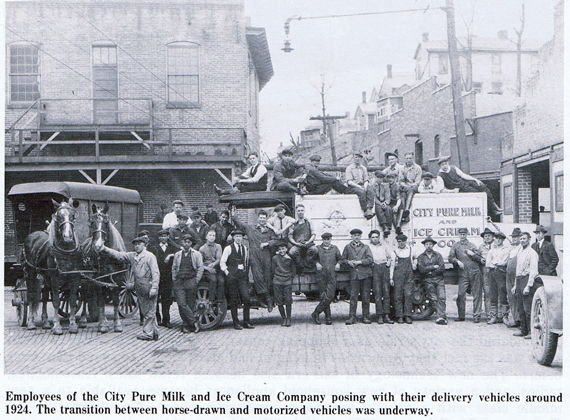
The debilitating effects of the Great Depression on the city are apparent in manufacturing statistics. In 1929 the city contained forty-eight manufacturing establishments employing 2,755 wage earners. By 1933 the number of manufacturers had dropped to thirty-four with only 988 workers. The Department of Commerce calculated that the value of products manufactured by these firms during this four-year period declined from almost ten million dollars to only slightly under 2.9 million dollars annually. By 1935 these indices began to improve. By mid-decade there were forty-one manufacturing establishments, employing 1,475 workers and producing goods totalling slightly over five million dollars. In 1938 a second slump in the local and national economy lowered the total number of manufacturing establishments to thirty. The leading employer in the city at that time was the Hall China Company with 815 workers. The next largest employer was the Crockery City Brewing Company with 132, the Louthan Manufacturing Company with 105, and the Potter's Supply Company with eighty-five employees. The various branches of ceramic production continued to be the principal industry in East Liverpool. Only 346 or 21.7 percent of those engaged in manufacturing labored in non-ceramic industries. By the end of the decade manufacturing in East Liverpool had stabilized at forty establishments producing over 5.5 million dollars worth of products and employing 1,440 workers. The leading firms manufacturing non-ceramic products included the American Paper Products Company which manufactured envelopes in the former Brunt Pottery, the East Liverpool Review which employed sixty- six, and the Golden Star Dairy Company which had moved to the city from Liverpool Township in 1937 to the former plant of the Crockery City Ice and Products Company. In earlier decades East Liverpool dominated manufacturing in the district; it was now reduced to a minor role.. . .
By December 1941 an air raid siren had been placed atop the Crockery City Brewery Building.
A MODERN LOOK AT THE WEBBER WAY BREWERY BUILDING.
On August 6, 2011 our usual photographic crew or Juanita Ruffner and her husband, Jeff Langdon, Matt Stewart and myself spent a couple hours photographing the interior of the Webber Brewery Building here in East Liverpool.
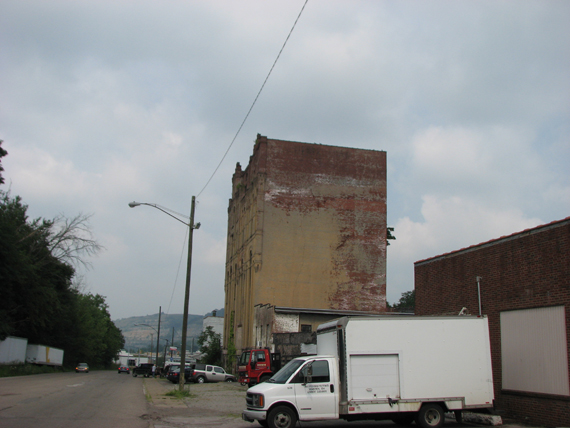
Up Ahead is our target.
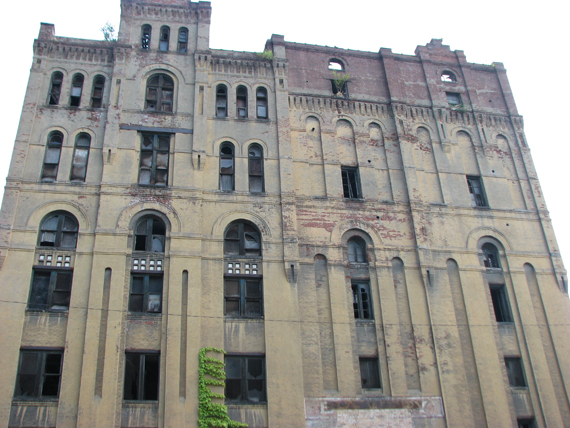
Hmmmmmm kinda high up there.
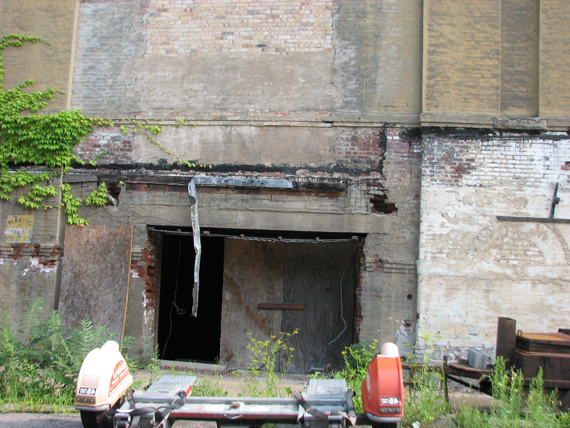
Our entrance. As we stepped though this doorway one person commented about what a lovely place for copperheads to live. The sent a tingle up the spine.
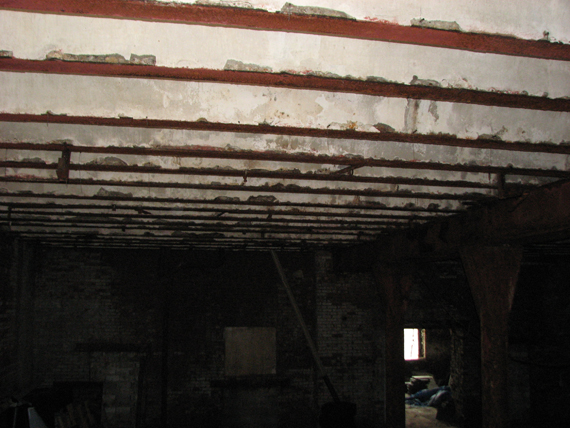
There were interesting ceilings through this building.

Ground floor, basement, not sure what the correct term is.
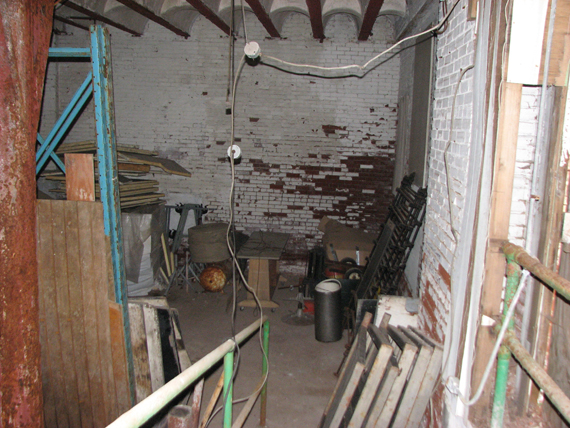
Part of the first room inside the entrance. A sloping ramp down to the floor.
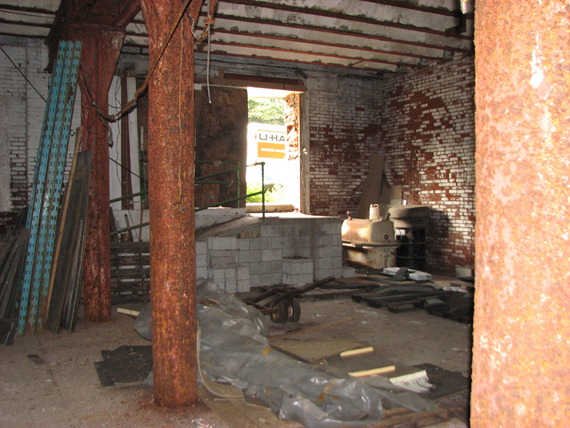
Second room on that first level.
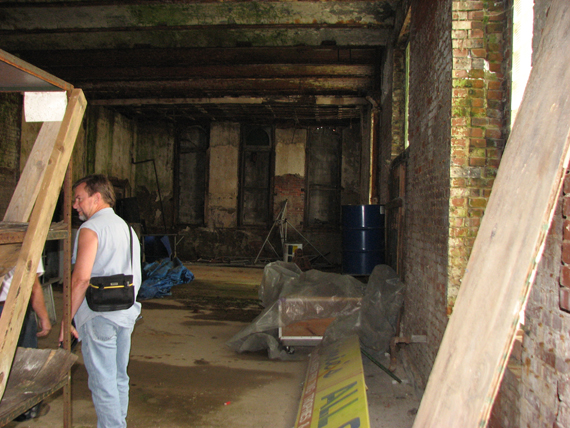
Same room looking west.
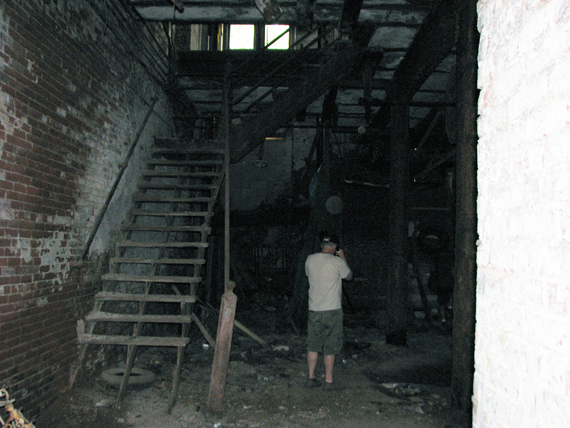
Another room first floor towards 8th Street.
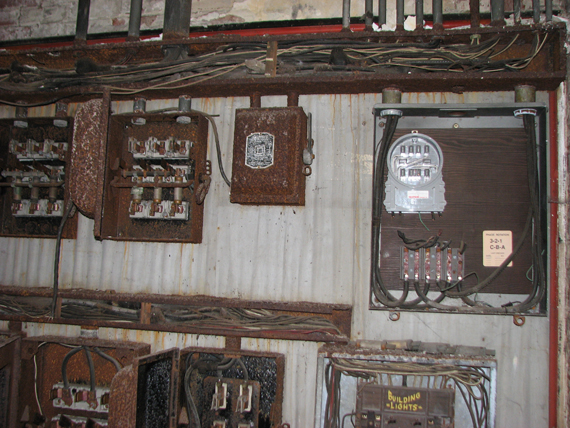
Electrical panel, Fuse boxes switch boxes for some of the machinery that was once used here.
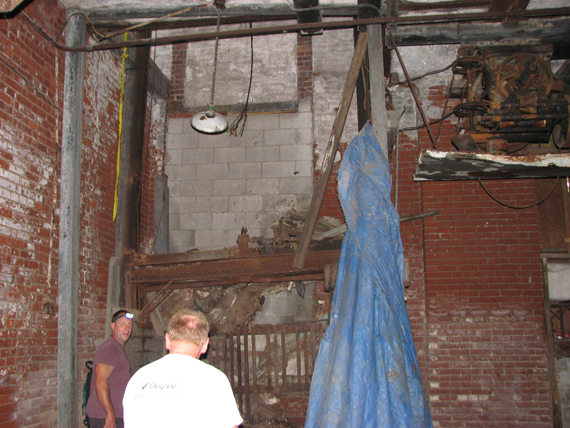
In front of those two people is the freight elevator. You can see the safety gated.
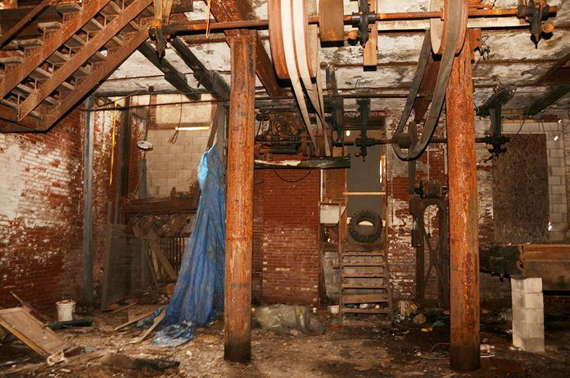
This and the next two pictures are still on the basement level and appears to be of the machinery that operated the freight elevator. Juanita Ruffner collection
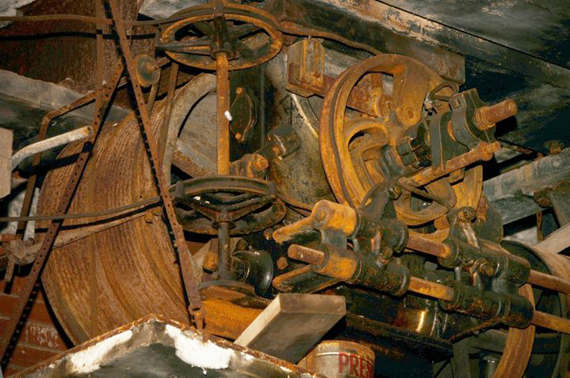
Juanita Ruffner Collection
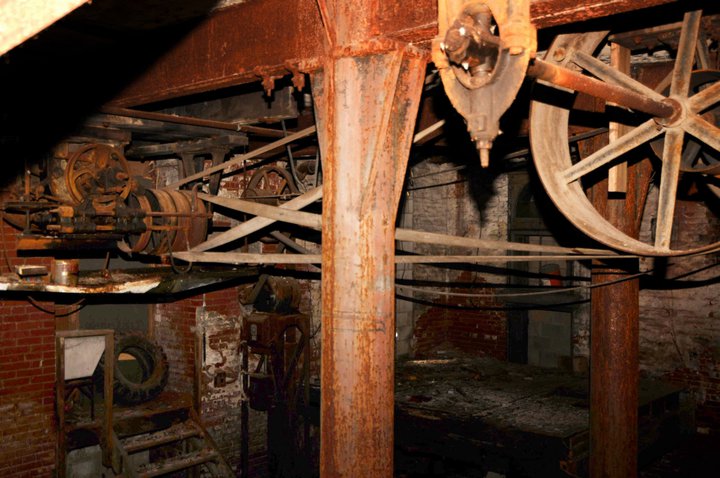
Juanita Ruffner collection
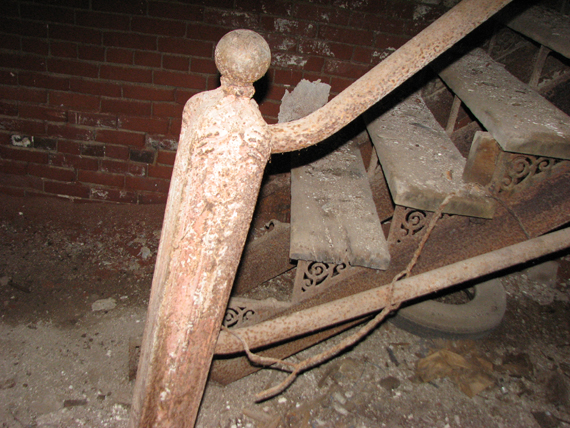
This is the steps going from the basement level to the first floor. Not in the greatest shape.

Through the steps you can see the that freight elevator again.
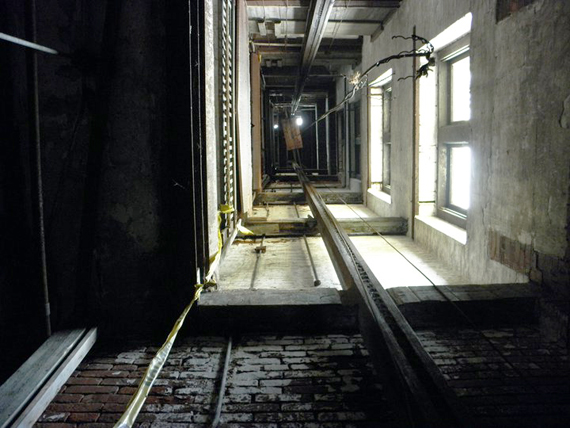
Freight elevator looking up from basement. Jeff Langdon pictures.
This site is the property of the East Liverpool Historical Society.
Regular linking, i.e. providing the URL of the East Liverpool Historical Society web site for viewers to click on and be taken to the East Liverpool Historical Society entry portal or to any specific article on the website is legally permitted.
Hyperlinking, or as it is also called framing, without permission is not permitted.
Legally speaking framing is still in a murky area of the law
though there have been court cases in which framing has been seen as violation of copyright law. Many cases that were taken to court ended up settling out-of-court with the one doing the framing agreeing to cease framing and to just use a regular link to the other site.
The East Liverpool Historical Society pays fees to keep their site online. A person framing the Society site is effectively presenting the entire East Liverpool Historical Society web site as his own site and doing it at no cost to himself, i.e. stealing the site.
The East Liverpool Historical Society reserves the right to charge such an individual a fee for the use of the Society’s material.